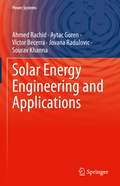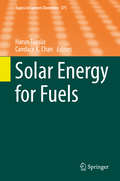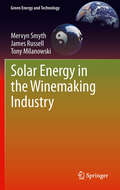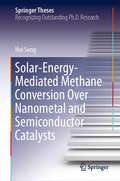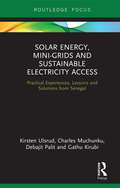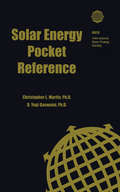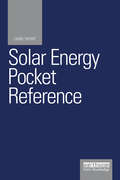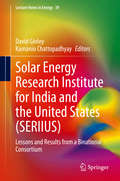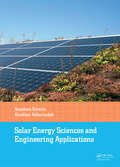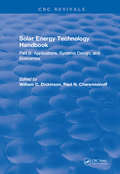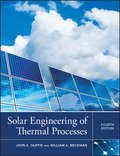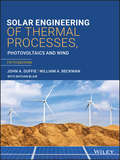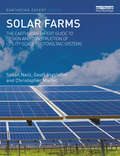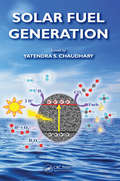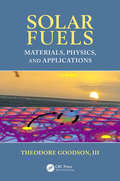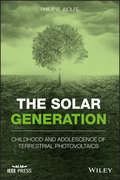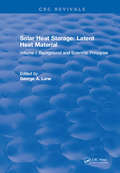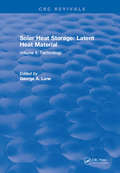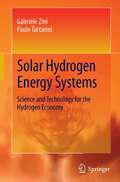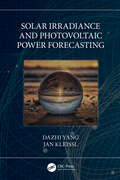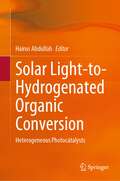- Table View
- List View
Solar Energy Engineering and Applications (Power Systems)
by Ahmed Rachid Aytac Goren Victor Becerra Jovana Radulovic Sourav KhannaSolar Energy Engineering and Applications gives a general and concise presentation of solar energy from a practical engineering perspective. The book provides readers with a comprehensive, accessible, and intuitive introduction to proven methods and tools for the design, implementation, and monitoring of solar energy systems and associated auxiliary technologies without covering detailed in-depth physics. Coverage includes key aspects of solar energy such as photovoltaic solar cells and systems, battery technologies, solar concentrators, and hybrid photovoltaic/thermal systems. Application areas such as homes, buildings, solar farms, street lighting, vehicles, and dryers are discussed. The methods for connecting solar farms and other photovoltaic installations to power distribution systems are explored in the context of smart grid technologies that are available to facilitate such connections. The book will be a valuable professional reference for practicing engineers and researchers involved in the applications of solar energy.
Solar Energy for Fuels
by Harun Tüysüz Candace K. ChanThe series Topics in Current Chemistry presents critical reviews of the present and future trends in modern chemical research. The scope of coverage is all areas of chemical science including the interfaces with related disciplines such as biology, medicine and materials science. The goal of each thematic volume is to give the non-specialist reader, whether in academia or industry, a comprehensive insight into an area where new research is emerging which is of interest to a larger scientific audience. Each review within the volume critically surveys one aspect of that topic and places it within the context of the volume as a whole. The most significant developments of the last 5 to 10 years are presented using selected examples to illustrate the principles discussed. The coverage is not intended to be an exhaustive summary of the field or include large quantities of data, but should rather be conceptual, concentrating on the methodological thinking that will allow the non-specialist reader to understand the information presented. Contributions also offer an outlook on potential future developments in the field. Review articles for the individual volumes are invited by the volume editors. Readership: research chemists at universities or in industry, graduate students
Solar Energy Harvesting with Photosynthetic Pigment-Protein Complexes (Green Energy and Technology)
by Sai Kishore Ravi Swee Ching TanThis book chronicles a few approaches to constructing biohybrid devices using photosynthetic protein complexes. Can the abundantly available solar energy be tapped to meet our rising energy demands using green and cheap active materials? Exploring nature’s own tiny solar factories, the photosynthetic proteins could hold the key. Photosynthetic pigment-protein complexes found in plants and certain types of bacteria transduce sunlight into biologically useful forms of energy through a photochemical charge separation that has a 100% quantum efficiency. Getting the photoproteins to perform this efficient energy conversion reaction in a semi-artificial setup is central to developing biohybrid solar technologies, a promising green alternative to today’s photovoltaics. This book looks into the existing challenges and opportunities in the field of biohybrid photovoltaics and provides a few prospective methods of enhancing the photocurrent and photovoltage in these devices. The book targets the readership of students, academics, and industrial practitioners who are interested in alternative solar technologies.
Solar Energy in the Winemaking Industry
by James Russell Mervyn Smyth Tony MilanowskiSolar Energy in the Winemaking Industry fully documents all aspects of the modern solar winery, beginning with the main drivers (environmental, economic and political) and detailing the current winemaking industry and solar technologies available. It details the various energy demands in the winemaking process from harvest to bottling and beyond. Solar Energy in the Winemaking Industry catalogues the range of wineries globally that have installed a substantial solar collecting system and uses case study material to give the reader an appreciation of the diversity of solar winery facilities. From large industrial-style wineries to boutique family-run wineries; from new state-of-the-art facilities to 15th-century palaces, the application for solar is limitless. The book deals finally with the physical design, installation and operation of the solar system within the winery environment, detailing the equipment, methodologies, processes and concerns that must be addressed in their creation. This presents the reader with a range of solar design and system options, including: generic system type; installation; mounting arrangements; operation; different module and inverter components and configurations; connection; and finance. Owners, managers and planners involved in the design, building or management of a winemaking facility will derive particular benefit from Solar Energy in the Winemaking Industry, but it will also be of interest to anyone with an interest in the wine or solar industries.
Solar-Energy-Mediated Methane Conversion Over Nanometal and Semiconductor Catalysts (Springer Theses)
by Hui SongThis book demonstrates that solar energy, the most abundant and clean renewable energy, can be utilized to drive methane activation and conversion under mild conditions. The book reports that coupling solar energy and thermal energy can significantly enhance methane conversion at mild temperatures using plasmonic nanometal-based catalysts, with a substantial decrease in apparent activation energy of methane conversion. Furthermore, this book, for the first time, reports the direct photocatalytic methane oxidation into liquid oxygenates (methanol and formaldehyde) with only molecular oxygen in pure water at room temperature with high yield and selectivity over nanometals and semiconductors (zinc oxide and titanium dioxide). These findings are a big stride toward methane conversion and inspire researchers to develop strategies for efficient and selective conversion of methane to high-value-added chemicals under mild conditions.
Solar Energy, Mini-grids and Sustainable Electricity Access: Practical Experiences, Lessons and Solutions from Senegal (Routledge Focus on Environment and Sustainability)
by Debajit Palit Kirsten Ulsrud Charles Muchunku Gathu KirubiThis book presents new research on solar mini-grids and the ways they can be designed and implemented to provide equitable and affordable electricity access, while ensuring economic sustainability and replication. Drawing on a detailed analysis of solar mini-grid projects in Senegal, the book provides invaluable insights into energy provision and accessibility which are highly relevant to Sub-Saharan Africa, and the Global South more generally. Importantly, the book situates mini-grids in rural villages within the context of the broader dynamics of national- and international-level factors, including emerging system innovation and socio-technical transitions to green technologies. The book illustrates typical challenges and potential solutions for practitioners, policymakers, donors, investors and international agencies. It demonstrates the decisive roles of suitable policies and regulations for private-sector-led mini-grids and explains why these policies and regulations must be different from those that are designed as part of an established, centralized electricity regime. Written by both academics and technology practitioners, this book will be of great interest to those researching and working on energy policy, energy provision and access, solar power and renewable energy, and sustainable development more generally.
Solar Energy Pocket Reference (Energy Pocket Reference Ser.)
by D. Yogi Goswami Christopher L. MartinDrawing on the experience of some of the foremost experts in the field, this easy-to-use and affordable pocket reference includes a wealth of information relating to solar energy and solar energy technologies. Topics covered range from solar angles, sun path diagrams, solar radiation and radiative properties of materials through to thermal collectors, thermal energy storage, photovoltaics and daylighting. The book also includes conversion factors and constants and is peppered throughout with helpful illustrations, equations and explanations. Anyone with an interest in solar energy, including professional architects and engineers, home builders, academic researchers, students and energy consultants will find a host of answers in this book – a practical assimilation of data, fundamentals and guidelines for application.
Solar Energy Pocket Reference: Second edition (Energy Pocket Reference)
by David ThorpeThis handy pocket reference provides a wealth of practical information relating to solar energy and solar energy technologies. Topics covered include solar radiation and its detailed measurement, the emissivity and absorption properties of materials, solar thermal energy collection and storage, photovoltaics (both at all scales), solar cooling, and the use of solar energy for desalination and drying. The book also includes conversion factors, standards and constants and is peppered throughout with helpful illustrations, equations and explanations, as well as a chapter making the business case for solar power. Anyone with an interest in solar energy, including energy professionals and consultants, engineers, architects, academic researchers and students, will find a host of answers in this book – a practical assimilation of fundamentals, data, technologies and guidelines for application.
Solar Energy Research Institute for India and the United States: Lessons and Results from a Binational Consortium (Lecture Notes in Energy #39)
by David Ginley Kamanio ChattopadhyayThis book describes the development, functioning, and results of a successful binational program to promote significant scientific advances in Earth-abundant photovoltaics (PV) and concentrated solar power (CSP), advanced process/manufacturing technologies, multiscale modeling and reliability testing, and analysis of integrated solar energy systems. SERIIUS is a consortium between India and the United States dedicated to developing new solar technologies and assessing their potential impact in the two countries. The consortium consists of nearly 50 institutions including academia, national laboratories, and industry, with the goal of developing significant new technologies in all areas of solar deployment. In addition, the program focused on workforce development through graduate students, post-doctoral students, and an international exchange program. Particular emphasis was placed on the following efforts: Creating disruptive technologies in PV and CSP through high-impact fundamental and applied research and development (R&D). Identifying and quantifying the critical technical, economic, and policy issues for solar energy development and deployment in India. Overcoming barriers to technology transfer by teaming research institutions and industry in an effective project structure. Building a new platform for binational collaboration using a formalized R&D project structure, along with effective management, coordination, and decision processes. Creating a sustainable network and workforce development program from which to build large collaborations and fostering a collaborative culture and outreach programs. This includes using existing and new methodologies for collaboration based on advanced electronic and web-based communication to facilitate functional international teams. The book summarizes the general lessons learned from these experiences.
Solar Energy Sciences and Engineering Applications
by Napoleon Enteria Aliakbar AkbarzadehSolar energy is available all over the world in different intensities. Theoretically, the solar energy available on the surface of the earth is enough to support the energy requirements of the entire planet. However, in reality, progress and development of solar science and technology depends to a large extent on human desires and needs. This is du
Solar Energy Technology Handbook
by E. W. DickinsonThe handbook, for convenient use, is divided into eight main units: (1) The Solar Resource; (2) Solar Thermal Collectors; (3) Photovoltaics; (4) Bioconversion; (5) Wind Energy; (6) Solar Energy Storage Systems; (7) Applications of Solar Energy; (8) Non-technical Issues. In addition there are three Appendixes containing unit-conversion tables and useful solar data. It became obvious early in this project that if proper coverage were to be given each of these areas it would be necessary to divide the handbook into two volumes. The first six units constitute Part A, Engineering Fundamentals and the last two units constitute Part B, Applications, Systems Design, and Economics. These volumes have been prepared primarily as reference books, but it is felt that many of the sections will prove useful for practicing engineers, scientists and students.
Solar Engineering of Thermal Processes
by John A. Duffie William A. BeckmanThe updated fourth edition of the "bible" of solar energy theory and applicationsOver several editions, Solar Engineering of Thermal Processes has become a classic solar engineering text and reference. This revised Fourth Edition offers current coverage of solar energy theory, systems design, and applications in different market sectors along with an emphasis on solar system design and analysis using simulations to help readers translate theory into practice.An important resource for students of solar engineering, solar energy, and alternative energy as well as professionals working in the power and energy industry or related fields, Solar Engineering of Thermal Processes, Fourth Edition features:Increased coverage of leading-edge topics such as photovoltaics and the design of solar cells and heatersA brand-new chapter on applying CombiSys (a readymade TRNSYS simulation program available for free download) to simulate a solar heated house with solar- heated domestic hot waterAdditional simulation problems available through a companion websiteAn extensive array of homework problems and exercises
Solar Engineering of Thermal Processes, Photovoltaics and Wind
by William A. Beckman John A. Duffie Nathan BlairThe bible of solar engineering that translates solar energy theory to practice, revised and updated The updated Fifth Edition of Solar Engineering of Thermal Processes, Photovoltaics and Wind contains the fundamentals of solar energy and explains how we get energy from the sun. The authors—noted experts on the topic—provide an introduction to the technologies that harvest, store, and deliver solar energy, such as photovoltaics, solar heaters, and cells. The book also explores the applications of solar technologies and shows how they are applied in various sectors of the marketplace. The revised Fifth Edition offers guidance for using two key engineering software applications, Engineering Equation Solver (EES) and System Advisor Model (SAM). These applications aid in solving complex equations quickly and help with performing long-term or annual simulations. The new edition includes all-new examples, performance data, and photos of current solar energy applications. In addition, the chapter on concentrating solar power is updated and expanded. The practice problems in the Appendix are also updated, and instructors have access to an updated print Solutions Manual. This important book: • Covers all aspects of solar engineering from basic theory to the design of solar technology • Offers in-depth guidance and demonstrations of Engineering Equation Solver (EES) and System Advisor Model (SAM) software • Contains all-new examples, performance data, and photos of solar energy systems today • Includes updated simulation problems and a solutions manual for instructors Written for students and practicing professionals in power and energy industries as well as those in research and government labs, Solar Engineering of Thermal Processes, Fifth Edition continues to be the leading solar engineering text and reference.
Solar Farms: The Earthscan Expert Guide to Design and Construction of Utility-scale Photovoltaic Systems (Earthscan Expert)
by Susan Neill Geoff Stapleton Christopher MartellThe market and policy impetus to install increasingly utility-scale solar systems, or solar farms (sometimes known as solar parks or ranches), has seen products and applications develop ahead of the collective industry knowledge and experience. Recently however, the market has matured and investment opportunites for utility-scale solar farms or parks as part of renewable energy policies have made the sector more attractive. This book brings together the latest technical, practical and financial information available to provide an essential guide to solar farms, from design and planning to installation and maintenance. The book builds on the challenges and lessons learned from existing solar farms, that have been developed across the world, including in Europe, the USA, Australia, China and India. Topics covered include system design, system layout, international installation standards, operation and maintenance, grid penetration, planning applications, and skills required for installation, operation and maintenance. Highly illustrated in full colour, the book provides an essential practical guide for all industry professionals involved in or contemplating utility-scale, grid-connected solar systems.
Solar Fuel Generation
by Yatendra S. ChaudharyAs the search for renewable sources of energy grows more urgent, more and more attention is focusing on the blueprint offered by biological photosynthesis for translating the energy of our Sun into energy rich molecules like H2 and carbohydrates, commonly known as "solar fuels." These solar fuels have enormous potential to store high densities of energy in the form of chemical bonds as well as being transportable. This book offers a complete overview of the promising approaches to solar fuel generation, including the direct pathways of solar H2 generation and CO2 photocatalytic reduction. Solar Fuel Generation is an invaluable tool for graduate students and researchers (especially chemists, physicists, and material scientists) working in this field.
Solar Fuels: Materials, Physics, and Applications
by Theodore Goodson IiiWritten for use as a text and reference for those interested in how new materials may be used to capture, store, and use solar energy for alternative energy resources in everyday life, Solar Fuels: Materials, Physics, and Applications discusses the fundamentals of new materials and the physical processes involved in their mechanisms and design. This book offers clear examples of current state-of-the-art organic and inorganic solar cell materials and devices used in the field, and includes experiments testing solar capability along with standardized examples. Last, but not least, it also gives a clear outline of the challenges that need to be addressed moving forward.
The Solar Generation: Childhood and Adolescence of Terrestrial Photovoltaics
by Philip R. WolfeThe first book to address the early development of the photovoltaic industry, and the pioneering researchers and companies in the sector Well before the end of this century, solar power will be the world's dominant power source. This book looks at the origins of this smart sustainable energy technology, tracing the pioneering years from its inception following the 1973 oil crisis to the end of the last millennium—just as the sector was poised for explosive growth. It focuses on the progress of the early terrestrial photovoltaic sector, often in the face of skepticism or apathy. It also covers the research and achievements of people and organizations within the PV business. Written by a leader in the field with more than 40 years of experience and an international reputation in the sustainable energy industry, The Solar Generation: Childhood and Adolescence of Terrestrial Photovoltaics offers enlightening coverage on the terrestrial PV industry. The first part of this 3-volume set provides a historical backdrop to the technology and tracks the development of research, markets, prices, applications, policies, and more. Part II is called the ‘encyclopedia’ and features a Who’s Who of the most influential people and profiles of key companies, events, and developments. Finally, Part III is the reference section and comes complete with glossaries, bibliography, and an incredibly comprehensive index. This text also: Addresses the early development of the PV sector from a global perspective Focuses on a defined period, leaving scope for later follow-ups as the sector matures Offers a study on the interactions between technology, policy, and market drivers The Solar Generation is an ideal book for all professionals in the power and energy field from every corner of the globe.
Solar Heat Storage: Volume I: Latent Heat Material
by LaneSeveral hundred technically acceptable PCMs were identified in Volume I of this set, and some of their thermodynamic and physical properties were present. Out of these, practical considerations have reduced the list to a few commercial PCMs for solar energy thermal storage heating and cooling applications. In Volume II these PCMs and their technology and discussed.
Solar Heat Storage: Volume II: Latent Heat Material
by G.A. LaneSeveral hundred technically acceptable PCMs were identified in Volume I of this set, and some of their thermodynamic and physical properties were present. Out of these, practical considerations have reduced the list to a few commercial PCMs for solar energy thermal storage heating and cooling applications. In Volume II these PCMs and their technology and discussed.
Solar Home Design Manual for Cool Climates
by Shawna Henderson Don RoscoeIf you want an inexpensive, environmentally sound source of energy for your home, you need look no further than the sun. Solar heat is not subject to rate increases, is totally renewable, pollution free and requires little or no technology. It is here for you today, and can easily provide up to 50% of your space and water heating requirements. This is a book that simply and clearly explains the principles of using solar energy to heat your home. Anyone building a new home, or renovating an old one can incorporate one or several aspects of solar energy into their design. Taking you through the process of designing a solar home from the ground up this manual is also a basic course in conservation and sustainable house design. If you live in a 'heating' climate, meaning if you have space heating requirements for most of the year then this is an invaluable resource. A house is the biggest single investment most of us will make in our lives - the way it is built and how it operates can reflect a long term investment in both the building and the planet.
Solar Home Heating Basics
by Dan ChirasAs fossil fuel supplies dwindle, home heating will be one of the major challenges in temperate and cold climates in upcoming years. The reserves of natural gas used to heat the majority of North American buildings are rapidly being depleted. This latest Green Energy Guide helps readers who want to slash their energy bills and reduce their dependence on scarce resources to navigate the sometimes confusing maze of clean, reliable, and affordable options.Solar Home Heating Basics focuses on renewable energy strategies to heat new and existing homes and small businesses. These include:*Energy efficiency, weatherization, and insulation*Solar hot air heating*Solar thermal systems*Passive solar heating*Backup heating systemsWhile most solar home heating resources are geared primarily towards new buildings, this practical guide addresses ways of retrofitting existing buildings, making solar a reality for many people.Packed with all the essential information home and small business owners need to find alternatives to conventional heating solutions, Solar Home Heating Basics is your key to a personal energy solution.Dan Chiras is a respected educator and the author of thirty books on residential renewable energy and green building, including The Homeowner's Guide to Renewable Energy and Power from the Sun. Dan is the director and lead instructor at the Evergreen Institute's Center for Renewable Energy and Green Building, where he teaches workshops on energy efficiency, solar electricity, solar hot water, small wind energy, green building, natural plasters, and natural building.
The Solar House: Passive Heating and Cooling
by null Daniel D. ChirasPassive solar heating and passive cooling—approaches known as natural conditioning—provide comfort throughout the year by reducing, or eliminating, the need for fossil fuel. Yet while heat from sunlight and ventilation from breezes is free for the taking, few modern architects or builders really understand the principles involved.Now Dan Chiras, author of the popular book The Natural House, brings those principles up to date for a new generation of solar enthusiasts.The techniques required to heat and cool a building passively have been used for thousands of years. Early societies such as the Native American Anasazis and the ancient Greeks perfected designs that effectively exploited these natural processes. The Greeks considered anyone who didn't use passive solar to heat a home to be a barbarian!In the United States, passive solar architecture experienced a major resurgence of interest in the 1970s in response to crippling oil embargoes. With grand enthusiasm but with scant knowledge (and sometimes little common sense), architects and builders created a wide variety of solar homes. Some worked pretty well, but looked more like laboratories than houses. Others performed poorly, overheating in the summer because of excessive or misplaced windows and skylights, and growing chilly in the colder months because of insufficient thermal mass and insulation and poor siting.In The Solar House, Dan Chiras sets the record straight on the vast potential for passive heating and cooling. Acknowledging the good intentions of misguided solar designers in the past, he highlights certain egregious—and entirely avoidable—errors. More importantly, Chiras explains in methodical detail how today's home builders can succeed with solar designs.Now that energy efficiency measures including higher levels of insulation and multi-layered glazing have become standard, it is easier than ever before to create a comfortable and affordable passive solar house that will provide year-round comfort in any climate.Moreover, since modern building materials and airtight construction methods sometimes result in air-quality and even toxicity problems, Chiras explains state-of-the-art ventilation and filtering techniques that complement the ancient solar strategies of thermal mass and daylighting. Chiras also explains the new diagnostic aids available in printed worksheet or software formats, allowing readers to generate their own design schemes.
Solar Hydrogen Energy Systems
by Paolo Tartarini Gabriele ZiniIt is just a matter of time when fossil fuels will become unavailable or uneconomical to retrieve. On top of that, their environmental impact is already too severe. Renewable energy sources can be considered as the most important substitute to fossil energy, since they are inexhaustible and have a very low, if none, impact on the environment. Still, their unevenness and unpredictability are drawbacks that must be dealt with in order to guarantee a reliable and steady energy supply to the final user. Hydrogen can be the answer to these problems. This book presents the readers with the modeling, functioning and implementation of solar hydrogen energy systems, which efficiently combine different technologies to convert, store and use renewable energy. Sources like solar photovoltaic or wind, technologies like electrolysis, fuel cells, traditional and advanced hydrogen storage are discussed and evaluated together with system management and output performance. Examples are also given to show how these systems are capable of providing energy independence from fossil fuels in real life settings.
Solar Irradiance and Photovoltaic Power Forecasting (Energy Analytics)
by Dazhi Yang Jan KleisslForecasting plays an indispensable role in grid integration of solar energy, which is an important pathway toward the grand goal of achieving planetary carbon neutrality. This rather specialized field of solar forecasting constitutes both irradiance and photovoltaic power forecasting. Its dependence on atmospheric sciences and implications for power system operations and planning make the multi-disciplinary nature of solar forecasting immediately obvious. Advances in solar forecasting represent a quiet revolution, as the landscape of solar forecasting research and practice has dramatically advanced as compared to just a decade ago. Solar Irradiance and Photovoltaic Power Forecasting provides the reader with a holistic view of all major aspects of solar forecasting: the philosophy, statistical preliminaries, data and software, base forecasting methods, post-processing techniques, forecast verification tools, irradiance-to-power conversion sequences, and the hierarchical and firm forecasting framework. The book’s scope and subject matter are designed to help anyone entering the field or wishing to stay current in understanding solar forecasting theory and applications. The text provides concrete and honest advice, methodological details and algorithms, and broader perspectives for solar forecasting. Both authors are internationally recognized experts in the field, with notable accomplishments in both academia and industry. Each author has many years of experience serving as editors of top journals in solar energy meteorology. The authors, as forecasters, are concerned not merely with delivering the technical specifics through this book, but more so with the hopes of steering future solar forecasting research in a direction that can truly expand the boundary of forecasting science.
Solar Light-to-Hydrogenated Organic Conversion: Heterogeneous Photocatalysts
by Hairus AbdullahThis book highlights the promising photocatalytic methods for synthesizing organic chemicals by simultaneously degrading the toxicity of raw substances used for organic synthesis. It presents various semiconducting materials with high catalytic activities in hydrogen evolution reactions (HERs) and hydrogenation reactions, as well as the material characterizations for identifying semiconductor photocatalysts. The focus is on understanding the hydrogen dissociation and activation of substances in the process of hydrogenation and the fabrication of nanostructured catalysts with desired activity and selectivity. Recent works show photocatalytic hydrogenation reactions with in situ generated H+ on catalyst surfaces utilizing initial chemicals such as nitrophenol, nitrobenzene, azobenzene, and benzene for valorization. In addition, the photocatalytic valorization of waste glycerol is also discussed. Besides the hydrogenation reactions, the reduction of oxygen to form H2O2 can be done with a photocatalytic method in atmospheric conditions. Some related perspectives and outlooks are also discussed for possible future development.
